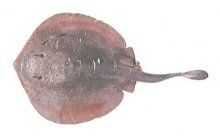Haller's Round Ray

Species Details
Urobatis Halleri
Urotrygonidae
Myliobatiformes
Inshore, Offshore
1 - 3 lbs.
9" - 23"
Haller’s Round Ray (Urobatis halleri) Fish Description
Also known as Little Round Stingray, or simply Round Stingray, the Haller’s Round Ray is a member of the Urotrygonidae family.
The Haller’s Round Ray has a stout and short tail and a long, fleshy, and serrated spine that can sting. It has a remarkable pectoral fin which has an almost round disc colored grayish or brown above. This feature of the Haller’s Round Ray also has some yellow spots. On the other hand, the Haller’s Round Ray’s underside is yellowish or white. This fish has diamond-shaped teeth.
Haller’s Round Ray Diet
Haller’s Round Ray loves to feed on benthic crabs and polychaete worms. As they grow older, Haller’s Round Ray turns to bivalve mollusks for food. They forage for food in the morning since they are more active when the waters are warmer (like during summer and fall). Interestingly, Haller’s Round Ray dig pits as they look for prey that might be hiding underneath. This act benefits smaller fishes because the Haller’s Round Ray uncovers food for the former as well. On the other hand, this stingray is preyed upon by the giant sea bass and the northern elephant seal.
Haller’s Round Ray Size
The average size of Haller’s Round Ray is 9 inches, and its weight is around one and a half pounds.
Interesting Facts About the Haller’s Round Ray
- Many swimmers in Southern California get stung by the Haller’s Round Ray when the former accidentally step on the latter.
- Interestingly, this kind of ray got its name Haller from the son of US Army soldier Granville Haller’s son who was stung by the fish when he was in San Diego Bay, wading in the waters.
- Stings from Haller’s Round Ray, though not fatal, can hurt very much. The wound is caused by the spine of the Haller’s Round Ray which contains venom.
- The teeth of the Haller’s Round Ray are sexually dimorphic; meaning, the central teeth of males are curved inward, highly pointed, and erect.
- The maximum with of the female Haller’s Round Ray’s pectoral fin disc is 31 cm and 25 cm for males.
- The Haller’s Round Ray sheds its tail spine and grows a new one periodically; the process takes the whole year.
Haller’s Round Ray — Fishing Techniques
Anglers can capture Haller’s Round Ray abundantly in the southern California surf. Usually, they are a product of bycatch when anglers try to fish for other species on the shallow waters near the surf line. It must be noted that the higher the water temperature, the higher the chance of catching the Haller’s Round Ray is.
Anglers can use any natural bait and a medium-sized tackle. They must handle this fish with care. The best precaution is to use pliers to grip the Haller’s Round Ray’s tail in order to flip it over and remove the hook. Under difficult circumstances, anglers can cut the stinger off since it will grow back in a few weeks. Haller’s Round Ray are not eaten; they are caught only for sport and also as aquarium fish.
Haller’s Round Ray Habitat and Distribution
This species of fish thrive in and are endemic to the North Pacific Ocean, from Panama to Humboldt Bay in northern California. Haller’s Round Ray can also be sighted along the coastal waters of the eastern and southern Pacific Ocean, and the Baja Peninsula.
They love swimming in waters close to the shore, as shallow as 15 meters or less; some, however, can be found in depths measuring 91 meters. They like rocky reefs, and sandy or muddy bottoms containing lots of eelgrass which they use as a hiding place. Haller’s Round Ray adores warm-temperate, or tropical waters (above 50 °F). During winter, they migrate to deeper waters where the temperature is more stable; young Haller’s Round Ray is less adaptive compared to the adult ones when it comes to temperature changes. During spring to fall, Haller’s Round Ray is abundantly found in Southern California’s bay and coastal waters.







